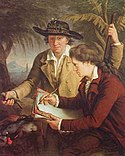User:MarSch/Main page
We are collaborating to create the best and most comprehensive encyclopedia ever and in this English version, started in 2001, we are currently working on 6,953,072 articles. This page is also available with simple layout.
Today's featured articleRagnar Garrett (12 February 1900 – 4 November 1977) was Chief of the General Staff in the Australian Army from 1958 to 1960. He completed staff training in England just as the Second World War broke out, joined the Second Australian Imperial Force, and commanded the 2/31st Battalion in England before seeing action with Australian brigades during the German invasion of Greece and the Battle of Crete in 1941. Promoted to colonel the following year, he held senior positions with I Corps in New Guinea and II Corps on Bougainville in 1944–1945. He was appointed Commander of the Order of the British Empire (CBE) for his staff work. After the war, he served two terms as commandant of the Staff College, Queenscliff, in 1946–1947 and 1949–1951. Between these appointments he was posted to Japan with the British Commonwealth Occupation Force. He took charge of Western Command in August 1951, became Deputy Chief of the General Staff in January 1953, and took over Southern Command as a lieutenant general in October 1954. He was knighted in 1959. (Full article...)
Recently featured:
Selected anniversariesFebruary 12: Lantern Festival in China (2025); Lincoln's Birthday in some parts of the United States; Red Hand Day
More anniversaries:
|
In the news
Did you know...
Today's featured pictureCharles Darwin (12 February 1809 – 19 April 1882) was an English naturalist, geologist, and biologist, widely known for his contributions to evolutionary biology. His proposition that all species of life have descended from a common ancestor is now generally accepted and considered a fundamental scientific concept. In a joint presentation with Alfred Russel Wallace, he introduced his scientific theory that this branching pattern of evolution resulted from a process he called natural selection, in which the struggle for existence has a similar effect to the artificial selection involved in selective breeding. Darwin published his theory of evolution with compelling evidence in his 1859 book On the Origin of Species. By the 1870s, the scientific community and a majority of the educated public had accepted evolution as a fact. However, many scientists initially favoured competing explanations that gave only a minor role to natural selection, and it was not until the emergence of the modern evolutionary synthesis from the 1930s to the 1950s that a broad consensus developed in which natural selection was the basic mechanism of evolution. Darwin's scientific discovery is the unifying theory of the life sciences, explaining the diversity of life. Darwin has been described as one of the most influential figures in human history and was honoured by burial in Westminster Abbey. This photograph of Darwin by Julia Margaret Cameron was taken around 1868.Photograph credit: Julia Margaret Cameron; restored by Adam Cuerden
|
Portals
Wikipedia in other languages
This Wikipedia is written in English. Many other Wikipedias are available; some of the largest are listed below.
-
1,000,000+ articles
-
250,000+ articles
-
50,000+ articles
Wikipedia's sister projects
Wikipedia is written by volunteer editors and hosted by the Wikimedia Foundation, a non-profit organization that also hosts a range of other volunteer projects:
-
Commons
Free media repository -
MediaWiki
Wiki software development -
Meta-Wiki
Wikimedia project coordination -
Wikibooks
Free textbooks and manuals -
Wikidata
Free knowledge base -
Wikinews
Free-content news -
Wikiquote
Collection of quotations -
Wikisource
Free-content library -
Wikispecies
Directory of species -
Wikiversity
Free learning tools -
Wikivoyage
Free travel guide -
Wiktionary
Dictionary and thesaurus





